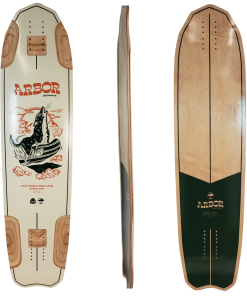Pantheon: Quest Longboard Skateboard Deck Pantheon
$ 148,75 $ 59,50
The Pantheon Quest is a highly capable distance longboard with a standard sized platform and concave profile that will handle virtually all terrain effectively. Consider the Quest a sort of jack-of-all-trades distance board. Uphills, downhills, high speeds and cruising will all be comfortable on this thing. And while the Nexus is equally as much a downhill and freeride board, the Quest truly focuses on distance in particular, highlighting the thinner overall profile for ergonomic, efficient pushing, with larger cutouts that will support a slightly slimmer truck setup.
The Quest is a fairly beefy but slim package. It will manage heavy weights up to about 250 pounds (has been tested up to 300 lbs with success, but we usually like recommending the even beefier Nexus over 250), while still providing a light dampening flex for riders down to about 150 pounds. The unidirectional shape of the Quest subconsciously pushes you forward, and its low, long, fairly stiff platform adds stability at speed compared to other Pantheon pushers like the Trip and Pranayama. It is slightly longer than the Nexus overall, but only because of the closed off nose and tail truck mounting area. Otherwise, the Quest has a 1-inch shorter wheelbase, and this actually translates into being able to stand slightly closer to the trucks and to reduce the amount of foot pressure you’ll be putting into the drops, which makes this a less aggressive board. The Nexus is stiffer and wider than the Quest and really should be considered for riders who intend on using the Nexus for sliding, where you’ll be actively using the drops to push the board around and control slides, as opposed to the drops simply just lowering the platform for easy pushing, foot braking, and added stability, like they do here on the Quest.
When setting up the Quest, we mostly recommend this board with 150mm RKP trucks and large, slim wheels like the 85mm Seismic Speed Vents. If you want the grippier, wider 85mm Orangatang Caguamas, you’ll have to size up to 165mm. Most riders will opt for the 50-degree setups in both front and back, but if you really want an extra stable setup, put a 43-degree in the rear. This will give comfort at speed, and some riders just generally prefer stability for pushing. Keep in mind that this will reduce agility when compared to the standard 50-50 setup.
Fast Shipping and Professional Packing
Our long-standing partnership with UPS FedEx DHL and other global carriers lets us offer a range of shipping services. Our warehouse staff is extremely skilled and will package your products according to our precise and exact specifications. Your items are carefully inspected and secured properly prior to shipping. We ship to thousands of customers each day in different countries. Our commitment to become the largest online retailer in the world is shown by this. Warehouses and distribution centers can be located in Europe and the USA.
Note that orders containing more than one item are processed according to the particular item.
We will carefully examine all products before they are shipped. Most orders are now shipped within 48 hours. The expected delivery time will be between 3-7 days.
Returns
Due to multiple parties such as the factory and the warehouse, we're unable to fully manage stock. The levels of stock can change at any time. Please understand it may happen that your order may be out of stock when your order has been made.
Our policy is valid for a period of 30 days. If you have passed 30 days in the past since you purchased and we are unable to offer an exchange or refund.
The item must not be in use and must be in its original condition. The item should be in the original packaging.
Related products
Longboard Skateboard Decks
Longboard Skateboard Decks
Longboard Skateboard Decks
Foster: Resurrector V2 Longboard Skateboard Deck Foster Skateboards
Longboard Skateboard Wheels
Longboard Skateboard Decks
DB: Coreflex Compound Longboard Skateboard Deck Origin Dist.
Longboard Skateboard Decks
Longboard Skateboard Wheels
Longboard Skateboard Decks
Longboard Skateboard Decks
Longboard Skateboard Decks
Longboard Skateboard Wheels
Combo Wheels: 65mm Blender Longboard Skateboard Wheels Foster Skateboards
Longboard Skateboard Decks
Longboard Skateboard Decks
Longboard Skateboard Decks
Longboard Skateboard Wheels
Longboard Skateboard Decks
Foster: Vulcan Mini Longboard Skateboard Deck Foster Skateboards
Longboard Skateboard Decks
Landyachtz: Drop Cat 33 Dune Longboard Skateboard Deck Landyachtz
Longboard Skateboard Decks
Longboard Skateboard Decks
Longboard Skateboard Decks
Foster Skateboards: The FINGY Longboard Skateboard Deck Foster Skateboards
Longboard Skateboard Decks
Longboard Skateboard Wheels
Combo Wheels: 57mm Mixer Longboard Skateboard Wheel Foster Skateboards
Longboard Skateboard Decks
Longboard Skateboard Decks
Pantheon: Chase Hiller Pro Model Longboard Skateboard Deck Pantheon
Longboard Skateboard Wheels
Combo Wheels: 63mm Platter Longboard Skateboard Wheels Foster Skateboards
Longboard Skateboard Wheels
Longboard Skateboard Decks
Longboard Skateboard Decks
slide pucks
Longboard Skateboard Decks
Longboard Skateboard Decks











































